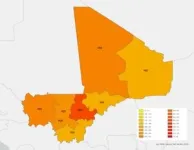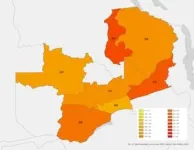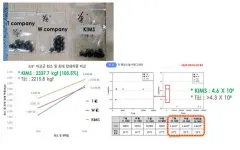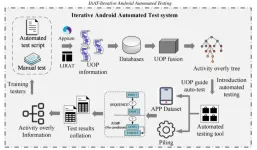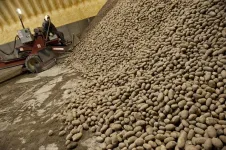(Press-News.org) Threats posed by the climate crisis disproportionally affect certain communities and social groups that are more exposed. People living in low- and middle-income (LMIC) countries are at heightened risk. Within these countries, women typically face higher climate risk than men.
To show where women working in agri-food systems – systems that encompass production, but also post-harvest handling and distribution – are most threated by climate change, an international team of researchers has developed a hotspot map that identifies and ranks localities by threat level.
“We show that significant climate hazards, high exposure faced by women in agri-food systems, and high vulnerability faced by women due to systemic gender inequalities converge particularly in central, east, and southern Africa, as well as in west and south Asia,” said the study’s first author Dr Els Lecoutere, who is a researcher at the CGIAR GENDER Impact Platform in Kenya. “The maps are potentially impactful as they can inform decision- and policymaking around gender-responsive climate action and guide the allocation of scarce resources to populations at highest risk.” The results were published in Frontiers in Sustainable Food Systems.
Hotspots for different reasons
“The climate-agriculture-gender inequality hotspot risk index captures the convergence of climate hazards, exposure, and vulnerability because of gender inequalities faced by women in agri-food systems,” said Lecoutere. The team of researchers involved in the study calculated each country’s risk based on these indicators. “We plotted the resulting ‘hotness’ score for each LMIC country into a color-coded map, which makes it possible to compare and contrast risks in different countries.”
The researchers also applied their methodology within four LMIC countries: Bangladesh, Pakistan, Zambia, and Mali. In the global ranking, they took places two, four, 13, and 18, respectively. Multiple drivers of risk contributed to these rankings.
“For the two focus countries in Asia, high climate hazards and women farmers’ exposure drives climate risks, whereas in the two focus countries in Africa structural inequalities play a larger role,” Lecoutere explained.
In Mali and Zambia, secondary resources confirm that women are restricted by norms that hinder their access to land ownership, information, and economic empowerment – limitations that negatively affect their ability to adapt to climate hazards. In Pakistan and Bangladesh, women contribute significantly to agricultural activities, but do so mostly informally. Their work often remains unrecognized, unpaid, or underpaid, which leaves them dependent on agriculture, and vulnerable to the adverse aftereffects of ever more frequent and severe climate hazards.
Starting points for policymaking
The researchers pointed to certain limitations of their study, for example a lack of data that has made it impossible to calculate a ‘hotness’ score for some countries, including small island development states. Yet, it is often these locations that are the most poverty- or conflict-stricken, and therefore vulnerable, making it plausible that women in these environments face significant climate risks.
While the team pointed out that in some cases data might not be available or sufficiently recent to be effectively used for policy making, their findings offer insights for other localities. One possible starting point is reducing women’s sensitivity to harm from climate hazards by addressing systemic gender inequalities and supporting the adaptive capacities of all agri-food system actors in gender-responsive ways.
“Another key use for the results of our study is the upcoming COP28 and ongoing negotiations around a loss and damage fund, and other climate investments. The hotspot maps can help decisionmakers and investors target finance and investments to the areas where women are hardest hit from climate change risks,” Lecoutere pointed out.
END
Inequality hotspot map shows where women in agriculture are hit the hardest by the climate crisis
Researchers show where women working in agri-food systems in Africa and Asia face the highest climate risk
2023-11-16
ELSE PRESS RELEASES FROM THIS DATE:
Reclaiming carbon fibers from discarded composite materials
2023-11-16
Minimizing energy consumption is a fundamental element in our journey towards sustainable societies, and advanced materials play a key role in this regard. Carbon-fiber-reinforced plastics (CFRPs) and carbon-fiber-reinforced thermoplastics (CFRTPs) are two prominent examples of composite materials that can significantly improve energy efficiency in various fields of application.
These composites are made of carbon fibers embedded in a polymer matrix, such as epoxy resin. Thanks to their low weight and remarkable mechanical strength, CFRPs and CFRTPs can greatly ...
Break free from dependence on Japan by developing core electric vehicle components
2023-11-16
A research team led by Dr. Jae-woong Ko from the Department of Engineering Ceramics at the Korea Institute of Materials Science(KIMS) has succeeded in localizing silicon nitride bearing ball manufacturing technology for electric vehicle drive modules. KIMS is a government-funded research institute under the Ministry of Science and ICT. This achievement is significant because it overcomes the limitations of foreign dependence and opens up the possibility of domestic supply and demand.
Silicon nitride bearing ...
Cannabis use during pregnancy is associated with adverse birth outcomes
2023-11-16
Infants prenatally exposed to cannabis are more likely to be born preterm, have a low birth weight, and require neonatal intensive care unit (NICU) care than infants without prenatal cannabis exposure, according to a study published today in the scientific journal Addiction. However, cannabis-exposed infants are not at greater risk of birth defects or death within one year, including sudden unexpected infant death.
First author Ms. Maryam Sorkhou comments, “The global increase in cannabis use among women of reproductive age also extends to pregnant women. ...
Landmark blood test to detect silent, lethal cancer
2023-11-16
Research that could lead to the first early detection blood test for pancreatic cancer has received critical funding from PanKind, The Australian Pancreatic Cancer Foundation.
Pancreatic cancer is one of Australia’s biggest killers, with poor survival rates marred by a lack of distinct symptoms and screening tools needed to detect the disease in its initial stages.
It’s hoped the test will, for the first time, accurately identify patients with early stages of pancreatic cancer – a crucial step towards improving survival ...
A better way to study Parkinson’s disease in the lab could lead to earlier diagnosis
2023-11-16
A recent study published in Progress in Neurobiology and led by researchers at the University of Arizona College of Medicine – Tucson has developed an improved method to study Parkinson’s disease in the lab. Along the way, researchers also uncovered clues that may help scientists figure out how to detect Parkinson’s earlier and point the way toward better treatments.
Around a million Americans are living with Parkinson’s disease, a neurological disorder that causes difficulty in movement, balance and cognition. Symptoms worsen until tasks like ...
Night-time radiative warming using the atmosphere
2023-11-16
Warming has played a crucial role in various industrial and agricultural processes throughout history. Night-time warming, however, presents a distinct challenge due to the absence of solar radiation. During the night, direct radiative heat loss to outer space through the atmospheric transparent window (8-14 μm) can cause temperature to drop below freezing, posing significant threats to agriculture (crops), transportation (outdoor cables), and more.
Traditionally, achieving night-time warming ...
A bi-directional iterative approach to Android automated testing
2023-11-16
With the benefits of reducing time-cost and human efforts, automated testing has been widely used for quality assurance of mobile applications (apps). However, in complex interactive activities, manual testing can achieve higher coverage. However, the effectiveness of manual testing is highly dependent on the vital User Operation Process (UOP) of experienced testers.
To solve the problems, a research team led by Zhenyu CHEN and Chunrong FANG published their new research on 15 Oct 2023 in Frontiers of Computer Science co-published ...
Oregon State researchers receive $2M to look for new ways to prevent organic potatoes from spoiling
2023-11-16
CORVALLIS, Ore. – Oregon State University researchers have been awarded $2 million from the U.S. Department of Agriculture to develop improved ways of preventing stored potatoes from sprouting, particularly in the organic sector.
This research is pivotal given the rapid rise of the organic market in U.S. agriculture, the scientists note.
“The organic potato industry cannot depend on traditional chemical anti-sprouting treatments since synthetic chemicals are banned in certified organic,” said Valtcho Jeliazkov of OSU’s College of Agricultural ...
Why it’s important to improve communication of unanticipated genomic findings to patients with late-stage cancer
2023-11-16
New research conducted by City of Hope and supported by the American Cancer Society focuses on developing scalable educational interventions to support informed patient decision making and consent, such as online tools and applications that include visual aids or interactive multimedia.
FINDINGS
Cancer genomics experts at City of Hope®, one of the largest cancer research and treatment organizations in the United States, conducted a qualitative study that underscored the importance of properly preparing patients for unanticipated, inheritable genetic findings prior to receipt of ...
New studies of brain activity explain benefits of electroconvulsive therapy
2023-11-16
Electroconvulsive therapy (ECT), formerly known as electroshock therapy, involves inducing a brief seizure in the brain using controlled doses of electricity. While ECT is highly effective for certain mental illnesses, particularly depression, the reasons for its efficacy have long puzzled the fields of psychiatry and neuroscience.
Now, researchers from University of California San Diego may have an answer. In two new studies published November 16, 2023 in Translational Psychiatry, they propose a new hypothesis that ECT alleviates depression symptoms by increasing aperiodic activity, a type of electrical activity in the brain that doesn’t follow a consistent pattern ...
LAST 30 PRESS RELEASES:
Making lighter work of calculating fluid and heat flow
Normalizing blood sugar can halve heart attack risk
Lowering blood sugar cuts heart attack risk in people with prediabetes
Study links genetic variants to risk of blinding eye disease in premature infants
Non-opioid ‘pain sponge’ therapy halts cartilage degeneration and relieves chronic pain
AI can pick up cultural values by mimicking how kids learn
China’s ecological redlines offer fast track to 30 x 30 global conservation goal
Invisible indoor threats: emerging household contaminants and their growing risks to human health
Adding antibody treatment to chemo boosts outcomes for children with rare cancer
Germline pathogenic variants among women without a history of breast cancer
Tanning beds triple melanoma risk, potentially causing broad DNA damage
Unique bond identified as key to viral infection speed
Indoor tanning makes youthful skin much older on a genetic level
Mouse model sheds new light on the causes and potential solutions to human GI problems linked to muscular dystrophy
The Journal of Nuclear Medicine ahead-of-print tip sheet: December 12, 2025
Smarter tools for peering into the microscopic world
Applications open for funding to conduct research in the Kinsey Institute archives
Global measure underestimates the severity of food insecurity
Child survivors of critical illness are missing out on timely follow up care
Risk-based vs annual breast cancer screening / the WISDOM randomized clinical trial
University of Toronto launches Electric Vehicle Innovation Ontario to accelerate advanced EV technologies and build Canada’s innovation advantage
Early relapse predicts poor outcomes in aggressive blood cancer
American College of Lifestyle Medicine applauds two CMS models aligned with lifestyle medicine practice and reimbursement
Clinical trial finds cannabis use not a barrier to quitting nicotine vaping
Supplemental nutrition assistance program policies and food insecurity
Switching immune cells to “night mode” could limit damage after a heart attack, study suggests
URI-based Global RIghts Project report spotlights continued troubling trends in worldwide inhumane treatment
Neutrophils are less aggressive at night, explaining why nighttime heart attacks cause less damage than daytime events
Menopausal hormone therapy may not pose breast cancer risk for women with BRCA mutations
Mobile health tool may improve quality of life for adolescent and young adult breast cancer survivors
[Press-News.org] Inequality hotspot map shows where women in agriculture are hit the hardest by the climate crisisResearchers show where women working in agri-food systems in Africa and Asia face the highest climate risk

